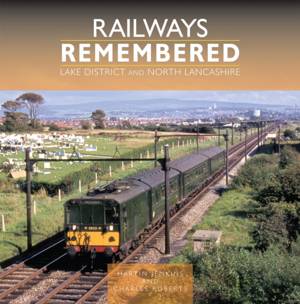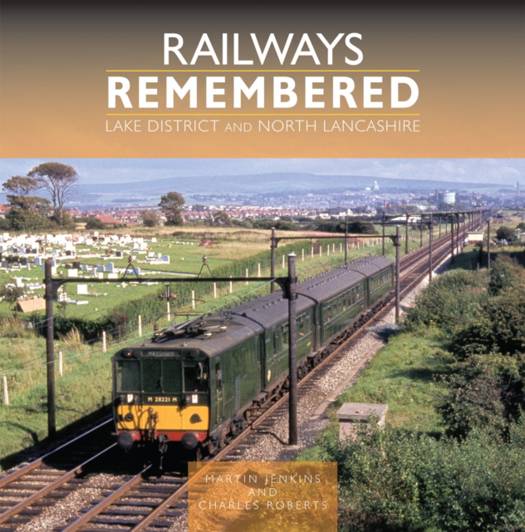
Bedankt voor het vertrouwen het afgelopen jaar! Om jou te bedanken bieden we GRATIS verzending (in België) aan op alles gedurende de hele maand januari.
- Afhalen na 1 uur in een winkel met voorraad
- Gratis thuislevering in België vanaf € 30
- Ruim aanbod met 7 miljoen producten
Bedankt voor het vertrouwen het afgelopen jaar! Om jou te bedanken bieden we GRATIS verzending (in België) aan op alles gedurende de hele maand januari.
- Afhalen na 1 uur in een winkel met voorraad
- Gratis thuislevering in België vanaf € 30
- Ruim aanbod met 7 miljoen producten
Zoeken
Railways Remembered: Lake District and North Lancashire
Martin Jenkins, Charles Roberts
Hardcover | Engels
€ 31,45
+ 62 punten
Omschrijving
The railways of the Lake District and North Lancashire are characterised by massive contrasts. From north to south, the area is intersected by the West Coast Main Line. Its series of tough grades, including the legendary Shap, presented a challenge for steam locomotives and crews for decades, and also for photographers seeking out new locations to record them at work. Along the way, the major centres of Carlisle, Lancaster and Preston were hives of activity, dealing with all manner of traffic from elsewhere in the country. It was also possible to see a rich variety of motive power at stations and loco sheds.
The spectacular Cumbrian Coast line conveyed trains via remote and dramatic scenery bordering the Irish Sea while linking industrial towns built around coal and steel. Branch lines to places like Silloth, Coniston, Windermere and Lakeside tapped into a growing tourist market until most were usurped by the private car as ownership grew. Stations at Blackpool proved a magnet for holidaymakers and day-trippers whilst Morecambe was served by an intriguing early electric service. The corridor connecting Preston to Blackburn, Burnley and beyond relied on a variety of passenger and goods traffic, especially coal. It was also notable for being the last major outpost of BR steam in 1968.
All these aspects feature in this new colour album, covering the period from the 1950s to the late 1970s, largely based around previously unpublished images, many of which are held by Online Transport Archive. Mainline and branch views cover freight and passenger workings in the steam, diesel and early electric eras. These are complemented by some remarkable views of industrial operations with a fascinating mix of locomotives in a range of locations. Another wonderfully nostalgic book to complement previous titles in the Railways Remembered series.
The spectacular Cumbrian Coast line conveyed trains via remote and dramatic scenery bordering the Irish Sea while linking industrial towns built around coal and steel. Branch lines to places like Silloth, Coniston, Windermere and Lakeside tapped into a growing tourist market until most were usurped by the private car as ownership grew. Stations at Blackpool proved a magnet for holidaymakers and day-trippers whilst Morecambe was served by an intriguing early electric service. The corridor connecting Preston to Blackburn, Burnley and beyond relied on a variety of passenger and goods traffic, especially coal. It was also notable for being the last major outpost of BR steam in 1968.
All these aspects feature in this new colour album, covering the period from the 1950s to the late 1970s, largely based around previously unpublished images, many of which are held by Online Transport Archive. Mainline and branch views cover freight and passenger workings in the steam, diesel and early electric eras. These are complemented by some remarkable views of industrial operations with a fascinating mix of locomotives in a range of locations. Another wonderfully nostalgic book to complement previous titles in the Railways Remembered series.
Specificaties
Betrokkenen
- Auteur(s):
- Uitgeverij:
Inhoud
- Aantal bladzijden:
- 160
- Taal:
- Engels
Eigenschappen
- Productcode (EAN):
- 9781800353510
- Verschijningsdatum:
- 31/01/2026
- Uitvoering:
- Hardcover
- Formaat:
- Genaaid
- Afmetingen:
- 249 mm x 249 mm

Alleen bij Standaard Boekhandel
+ 62 punten op je klantenkaart van Standaard Boekhandel
Beoordelingen
We publiceren alleen reviews die voldoen aan de voorwaarden voor reviews. Bekijk onze voorwaarden voor reviews.









